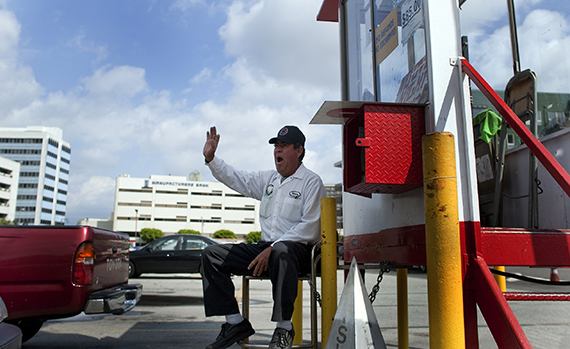How much does parking cost in Los Angeles? For one project just blocks away from Union Station, it could be as much as $28 million.
Trammell Crow Co.’s La Plaza Cultura Village, a $140 million development rising on the site of two former public parking lots, is set to include 365 apartments and 43,000 square feet of retail across a 425,000-square-foot village on the corner of Spring Street and Cesar E. Chavez Avenue. Thanks in part to the city’s zoning codes, the project will also need to include a whopping 720 parking spaces.
The price tag for the parking could end up being 20 percent of the project’s total cost, according to Brad Cox, an executive at the company. That’s despite less rabid demand for parking due to the rise of Uber and Lyft, and a younger population more willing to take public transport. But the zoning code doesn’t take those shifts into account, and developers across Los Angeles say it’s put them into a tight spot.
“The code is not flexible and it’s not really oriented around what the actual demand is,” said Allan Abshez of Loeb & Loeb, a former planning commissioner who now represents developers. “It’s based on what demand historically was.”
City of cars
The conventional wisdom goes that L.A. is about as car-dependent a metropolis as you can get, and the proof is in its parking. The city created its off-street parking regulations last century as it wrestled with both rising populations and car use. However, since then, the city has taken a different path than its peers.
In 2010, L.A. County had 18.6 million parking spaces, or 3.3 spaces for every vehicle within its limits, according to a 2015 study published by the American Planning Association. The study found the zoning code to be a key driver of parking development.
About 45 percent of La Plaza Cultura’s parking is for the project’s commercial component, Cox said. And a part of an agreement Trammell Crow made when leasing the site from the County, up to 150 County employees will have spots. But the rest of it is for the apartments, about one spot per unit, which Cox believes will not be fully utilized as L.A. becomes less car dependent.
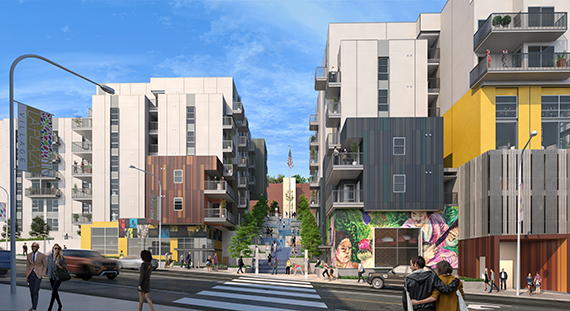
A rendering of Trammell Crow’s La Plaza Cultura Village (Johnson Fain)
To fit the code, a single-family home in L.A. must have two dedicated parking spaces. In multifamily buildings, two-bedroom units require two spots, while one-bedroom units require 1.5 spaces and studios require one spot.
Other major cities, including New York, San Francisco, Boston, and London, eliminated minimum-parking requirements in certain areas, said Michael Manville, an urban planning professor at UCLA. By forcing projects to include more than one space per unit, L.A. is in the “upper end of big-city parking requirements,” he said.
Some ordinances have tried to lower requirements. The Adaptive Reuse Ordinance, for example, requires historic properties to maintain just the number of parking spaces that existed on the site when the rule was passed. This incentivized developers, Manville said, to turn underutilized and historic buildings into apartments and live/work spaces.
Developers can also tap into affordable housing density bonuses to reduce the per-unit parking requirement, an option Trammell Crow availed of at the affordable housing portion at La Cultura. The developer wasn’t, however, automatically cut any slack for being next to Union Station.
In 2012, the city unsuccessfully tried to reduce parking requirements. It adopted the Modified Parking Requirement District Ordinance, which gave neighborhoods the ability to create districts with lower minimums. Not a single neighborhood opted to do so, according to Thomas Rothmann, a senior planner for the city. Some of this, Cox said, was based on longtime residents’ fears that new projects would lead to a rush of people parking on their streets.
Circumventing NIMBYism
Planning officials have tried to address the issue on the local level, targeting transit areas such as the Cornfields with the Cornfields Arroyo Seco Specific Plan and the Vermont/Western Transit Oriented District Specific Plan. But there’s been a push to take a more radical approach.
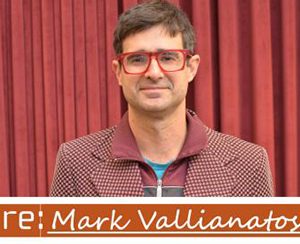
Mark Valliantos (re:code)
One effort — re:code LA, an initiative to overhaul the city’s 70-year-old zoning code — will attempt to reduce the city’s parking requirements, said Mark Vallianatos, a member of re:code LA’s Zoning Advisory Committee. The consultant working with the city on re:code, Austin-based Code Studio, recently offered some initial recommendations, which included potentially eliminating all minimum-parking requirements for Downtown, Vallianatos said.
Other suggestions, however, were more incremental. Code Studio suggested maintaining similar levels of parking in more suburban areas and merely reducing the minimum number of spaces for developments near public transit.
Vallianatos said he worries the recommendations for suburban areas are too deferential to groups of residents fearful about reduced parking.
“You’re not far enough from the start if you’re pre-conceding,” he said, adding it was key to communicate the grander vision to the public at large.
Looming over all the parking debate and all other planning issues, however, is the Neighborhood Integrity Initiative, otherwise known as Measure S, the March ballot measure that would place a moratorium on most projects requesting a zone change or general plan amendment.
The NII would prevent general amendments to the zoning code related to parking, and would also prevent individual projects from getting parking reductions beyond the general rules in the zoning code.
Scratching the surface
The ongoing rebirth of Downtown Los Angeles has led to a largely built-out historic core with little developable space. As a result, some developers turn to the closest thing to open parcels the area has to offer: surfacing parking lots.
In their current form, they give the appearance of a “vacant, blighted streetscape,” Vallianatos said, but “the irony is that all of those surface parking lots are now good development sites, because they’re vacant parcels of land that can go from zero housing units or zero job-creating commercial spaces to very large sites.”
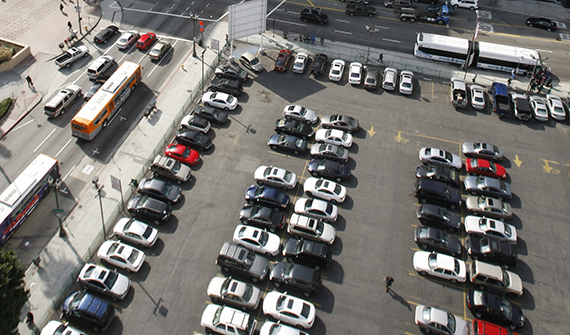
A Joe’s Auto Parks lot in DTLA (Allen Schaben, Getty Images)
L&R Group of Companies, the Los Angeles–based owner and operator of Joe’s Auto Parks and WallyPark, is riding the wave. It partnered with Hankey Investment Company, Jamison Services, Falcon California Investments and Highlands Capital to redevelop a lot at 1200 South Figueroa St. into Circa, a massive two-tower mixed condo and retail project. It also teamed up with developer Geoff Palmer on a 10-story, 439-unit apartment building slated for a parking lot site it owns just north of Olympic Boulevard.
“The value of development has made it often times more attractive to build on the lots as opposed to maintaining them in their current use,” said Colliers’ Adam Tischer, who has brokered many parking lot sales.
In 2014, L&R sold a surface lot at 1050 South Grand Street in DTLA to Trumark Urban, a San Francisco-based firm that immediately began developing it into a 25-story, 151-unit condominium tower. Dubbed TEN50, the $100 million project topped off this spring and has sold out its first phase.
L&R is also proposing a 52-story tower of its own at the southern tip of South Park. The company filed plans with the city this month for a mixed-use project at 1600 S. Figueroa St., on the site of the Toyota of Downtown L.A. dealership. It’s slated to include 202 condominiums, 134 rental units, and a 250-room hotel.
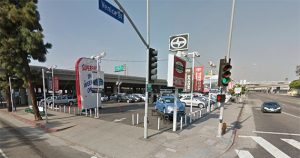
The dealership at 1600 South Figueroa Street
But in some cases, L&R is sticking to its knitting. Joe’s Auto Parks COO Kevin Litwin, who declined multiple requests to comment for this article, told Curbed last year that the company is considering tearing down a building at the corner of Third and Main streets, which houses Shish Kabob restaurant and Five Star Bar, and adding another parking lot.
A changing DTLA’s impact on parking
Tischer isn’t the type you’d expect to go car-free. He’s a flashy broker who recently owned a Porsche 911 Turbo – a car “that incentivized [him] to get speeding tickets,” he joked.
But in 2015, Tischer, like many other Angelenos living Downtown, ditched his car and tried navigating the city on foot, bike, train and Uber. It was a short-lived experiment: Annoyed by the inability to rent fancy rides for road trips and desiring privacy when making phone calls on the road, he ultimately bought a Tesla.
“I can’t tell you the pleasure I feel of stepping in my car and having the stereo resume the same song I was playing,” he said.
Advocates such as Vallianatos hope that more people will take the carless plunge, reducing the need for surface lots and parking-heavy developments in the city. As signs of progress, he points to Mobility 2035, the comprehensive transportation plan to add dozens of new bike and bus-only lanes in the city, and a sales-tax ballot measure approved in November that is expected to generate $860 million annually for rail expansion and upgrades.
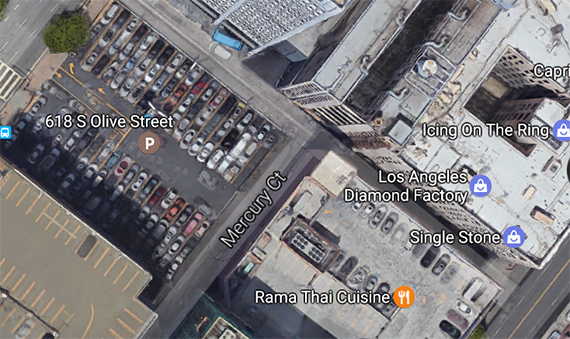
An L&R-owmed lot at 618 S. Olive St. (Google Earth)
Ride-sharing apps such as Uber and Lyft are also changing the game, Abshez, the attorney, said, with Angelenos beginning to mimic their counterparts in more public transit-friendly cities such as New York. If the trend continues, Los Angeles could find itself “with big parking structures that are significantly empty, and lots of locations on the landscape — surface parking lots — that are underutilized,” he said.
But Tischer warned against parking lot eulogies. He said that while more Downtown residents may give up car ownership, population growth may still see the total number of cars go up. And while ride-sharing apps have lessened the demand, the vehicles — even those in the likely eventuality of driverless fleets — still need places to park.
Driverless cars would “have to [park] somewhere in proximity to where the demand is, and they’re certainly not going to be out in the city of Commerce,” Tischer said, suggesting Downtown would make the most sense as a fleet base.
The quiet incentive
Any changes would likely be welcomed by a development community that sees the requirements as an unnecessary and expensive burden.
Bobby Turner, principal of Turner Impact Capital, said that at a time when people are rethinking their approach to driving, the cost of parking remains “prohibitively expensive” — as much as $20,000 per unit.
“Why aren’t we changing our building code such that our new construction has lower parking requirements?” he asked.
If developers are forced to build parking spots, it continues to create a “quiet incentive” to own a car, Manville said.
“We can vote as much as we want to raise our sales tax and build trains,” he said, “but if our entire land-use system is structured around making room for cars, we’re going to have what we have right now.”
